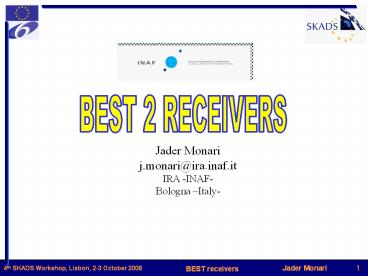BEST 2 RECEIVERS - PowerPoint PPT Presentation
1 / 21
Title:
BEST 2 RECEIVERS
Description:
The Best-2 platform is composed by 32 receivers 8 cylinders and offers about ... IP3 spurs product -10dB lower than the system thermal noise (KTB) IIP3 -60dBm ... – PowerPoint PPT presentation
Number of Views:33
Avg rating:3.0/5.0
Title: BEST 2 RECEIVERS
1
BEST 2 RECEIVERS
Jader Monari j.monari_at_ira.inaf.it IRA
-INAF- Bologna Italy-
2
The Best-2 platform is composed by 32 receivers 8
cylinders and offers about 1440 m2 of collecting
area. It is primarily aimed to test adaptive
beamforming, calibration techniques, RFIs
algorithms and develop / test some crucial
technology.
3
BEST-x GENERAL ARCHITECTURE
4
Active device
OIP3gt32dBm
P1dBgt16dBm
NFlt0.2dB
5
Balanced Architecture
- A1A2
- Hybrids good phase and amplitude match
- NFA1NFA2 reduction
(NF ILInput_HybridNFA)
6
Balanced LNA, the prototype
S22
S21
Sim _at_ 408 MHz Meas _at_ 408 MHz
S21 (dB) 24 24.4
NF (dB) 0.22 0.45
Te (K) 15 31.5
OIP3 (dBm) 34.5 34.5
P1dBout 21.2 21.2
NFlt0.5 between 380MHz and 450MHz
OIP3 gt 34dBm between 350 e 450 MHz
7
Full Front end chain
8
Inside the FE
RFout
NF0.45dB Tn32K Gain60dB BW16MHz_at_408MHz
OIP3gt33dBm Input RLgt15dB Output RLgt15dB Power
Supply10-15Volt_at_245mA
9
Comparision among several FEs
10
Mechanical assembly of FE
3 stages FE
Discharges protection circuit
Opt. TX
11
Federicos Talk
12
IF stages
13
IF Receiver specifications
- IP3 spurs product -10dB lower than the system
thermal noise (KTB) ? IIP3 gt -60dBm - Auxiliary 408MHz out as monitor
- IF30MHz, OL378MHz
- Pin_ADCBW-35/-30dBm _at_16MHz (ADC Berkeley)
- PinKTB-107dBm (Tb20K) /-100dBm (Tb500K) ?
GSYSTEM70dB ? GRX35dB - Digital controlled attenuator (31.5dB with 0.5dB
step) for match the gain of the different
receivers and to have the right dynamic range at
the ADC section - Only an MMIC model for all the receiver parts (1
RF, 1 OL and 4 IF)
14
Carrier Board
uP
IF
- Power monitor (AD8362) ? AD10dB
- Control of switch on-off each amplifier
(diagnostic and power-safe via software)
15
From the Optical link to the receiver
Light
16
Inside the IF receiver.
To A/D
Signal paths RF, IF, OL and digital
controlmonitor.
17
Mechanical assembly Carrier-RXO
18
Two N-S Cylinders of Carrier-RXO
485 bus
19
To LAN
19
(No Transcript)
20
(No Transcript)
21
Conclusions
- Receivers, analogue optical links and data
aquisition for BEST-2 are already installed and
under test and programming
2) Future work will be to design and develop a
new IF to sample directly the 408MHz
3) New mechanical chassis for next generation FE
are going to use to simplify test and assembly
4) New digital uC is going to be used in order
to monitor temperatures and eventually to control
NGs or heaters/peltier to stabilize the FE
environment































